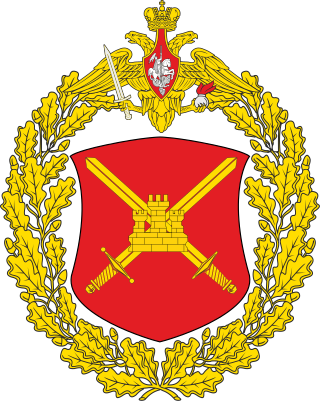A tank corps was a type of Soviet armoured formation used during World War II.
A mechanised corps was a Soviet armoured formation used prior to the beginning of World War II and reintroduced during the war, in 1942.
A rifle corps was a Soviet corps-level military formation during the mid-twentieth century. Rifle corps were made up of a varying number of rifle divisions, although the allocation of three rifle divisions to a rifle corps was common during the latter part of World War II.

The 150th Idritsa-Berlin Order of Kutuzov 2nd Class Motor Rifle Division of the Russian Ground Forces is a tank and artillery division that was re-instituted in 2016. It is part of the 8th Guards Army, which was reformed in 2017, in the Southern Military District.

The 10th Guards Motor Rifle Division was a division of the Soviet Ground Forces. The full name of its predecessor division was the 10th Guards Rifle Pechengskii, Twice Order of the Red Banner, Order of Alexander Nevsky, Order of the Red Star Division. The 10th Guards Rifle Division was formed from the 52nd Rifle Division in late 1941.
The 3rd Guards Volnovakha Red Banner Order of Suvorov Motor Rifle Division was a division of the Soviet Army from 1957 to around 1992. It traced its history from the highly decorated 3rd Guards Rifle Division of World War II. The 3rd Guards Rifle Division was formed from the 153rd Rifle Division.

The 120th Guards Mechanised Brigade is a mechanised infantry brigade of the Belarus Ground Forces. It is the heir to the traditions of the Red Army 120th Guards Rifle Division which became the 120th Guards Motor Rifle Division in 1957.
The 87th Rifle Division was an infantry division of the Red Army, active before, during the Second World War and afterwards.

The 308th Rifle Division was a rifle division of the Soviet Red Army during World War II. The division was formed three separate times during the course of the war.
The 266th Rifle Division was a rifle division of the Soviet Red Army during World War II. The 266th was formed three times during the war.
The 11th Tank Division was a Soviet tank division initially formed in 1940 at Tiraspol and destroyed in 1941; it was then formed as a tank corps in May 1942. This unit was subsequently reorganized as the second formation of the 11th Tank Division in 1945.
The 69th Rifle Division was an infantry division of the Red Army and later the Soviet Army, formed twice.
The 6th Rifle Corps was a rifle corps of the Soviet Union's Red Army and later the Soviet Army, formed three different times.
The 29th Rifle Division was an infantry division of the Red Army and later the Soviet Army.
The 32nd Rifle Division was an infantry division of the Red Army and later of the Soviet Army, formed three times.
The 34th Guards Rifle Division was a rifle division of the Red Army during World War II.
The 62nd Rifle Division was an infantry division of the Soviet Union's Red Army, formed four times and active during World War II and the postwar period. The division was formed in 1936 and fought in the Winter War and Soviet occupation of Bessarabia and Northern Bukovina. It was destroyed during the Battle of Kiev in summer 1941. The division was reformed in November 1941. It fought in the defense against the German offensive Case Blue during the summer of 1942. After suffering heavy losses, it was withdrawn from combat but was sent back to fight in the Battle of Stalingrad in November. The division suffered heavy losses and was disbanded on 2 November. The division was reformed a third time from a rifle brigade in April 1943. It fought in Operation Suvorov, Operation Bagration, the East Prussian Offensive and the Prague Offensive. It was disbanded in the summer of 1945. The 62nd was reformed a fourth time by renaming the 360th Rifle Division, but became the 108th Motor Rifle Division in 1957.
The 166th Rifle Division was an infantry division of the Soviet Union's Red Army that fought in World War II, formed twice. The division's first formation was formed in 1939 and wiped out in the Vyazma Pocket in October 1941. In January 1942, the division reformed. It fought in the Battle of Demyansk, the Battle of Kursk, Belgorod-Khar'kov Offensive Operation, Vitebsk–Orsha Offensive, Polotsk Offensive, Šiauliai Offensive, Riga Offensive and the Battle of Memel. It was awarded the Order of the Red Banner.
The 325th Rifle Division was formed in September 1941, as a standard Red Army rifle division, made up of older reservists and young men with no prewar training. As with many other divisions in the 320–330 series it was flung into the fighting west of Moscow in the 10th Army to defend the capital and then to take part in the winter counteroffensive. After a year on a quiet sector the division rejoined the fighting in the late winter of 1943, eventually distinguishing itself sufficiently to be redesignated as the 90th Guards Rifle Division. After disappearing from the Soviet order of battle for more than a year a new division was formed in the spring of 1944, based on a cadre of two distinguished rifle brigades, and gave very creditable service for the duration, completing its combat path in East Prussia.



